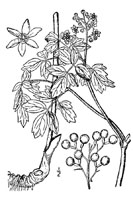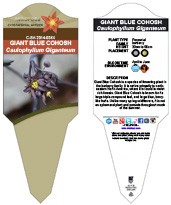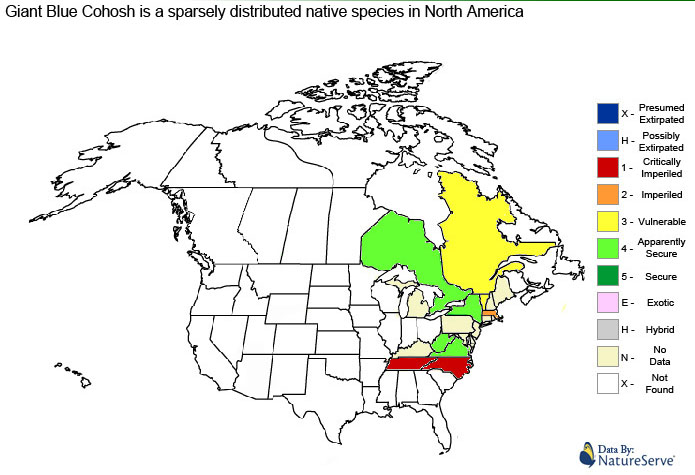
Giant Blue Cohosh is a species of flowering plant in the barberry family. It is native primarily to northeastern North America, where it is found in moist rich forests. Giant Blue Cohosh is known for its large triple-compound leaf, and large blue, berry-like fruits. Unlike many spring wildflowers, it is not an ephemeral plant and persists throughout much of the summer. Caulophyllum Giganteum ranges from Ontario and Quebec east to Vermont and south through Tennessee and North Carolina and is not particularly common anywhere in its range. This species has been newly designated a full species and was formerly considered a subspecies of Caulophyllum thalictroides, a heavily traded and relatively more common medicinal plant that is wild-harvested. Despite similar morphological characteristics, the two species have distinct ranges and phenology, which can help reduce confusion by collectors. The genus name Caulophyllum come from the Greek word kaulos which means 'stem' and phyllon which means 'leaf'. The species name giganteum translates to the word large, a reference to the larger fruit of the giant blue cohosh plant.
There is currently no commercial applications for giant blue cohosh.

Within the realm of rational and holistic medicine, giant blue cohosh is a traditional herb of many North American Indian tribes and was used extensively by them to facilitate child birth. Modern herbalists still consider it to be a female orientated herb and it is commonly used to treat various gynaecological conditions. Giant Blue Cohosh is believed to stimulate the uterus, reduce inflammation, expel intestinal worms and have diuretic effects. The root is anthelmintic, antispasmodic, diaphoretic, diuretic, emmenagogue, oxytocic and sedative. An infusion of the root in warm water is taken for about two weeks before the expected birth date in order to ease the birth his infusion can also be used as an emmenagogue and a uterine stimulant. Giant Blue Cohosh should therefore be used with some caution by women who are in an earlier stage of pregnancy since it can induce a miscarriage or early delivery. The plant is also taken internally in the treatment of pelvic inflammatory disease, rheumatism and gout. The powdered root can have an irritant action on the mucous membranes, therefore any use of this plant is best under the supervision of a qualified practitioner.
Please note that MIROFOSS does not suggest in any way that plants should be used in place of proper medical and psychological care. This information is provided here as a reference only.
Although giant blue cohosh has been listed as a toxic plant species; The roasted seed have been used as a coffee substitute. The seeds are about the size of large peas, but are not produced in abundance.
Giant Blue Cohosh produces around four to eighteen purple flowers in early spring. It blooms around ten to fifteen days earlier than its relative, blue cohosh. Each flower is 3cm to 6cm long with 1mm to 3mm bracts. Each flower is violet, or yellowish green, with six petals. Each flower contains six sepals, six stamens, and one pistil. Giant Blue Cohosh is self-sterile and requires outcrossed pollen to reproduce by seed. The fruit of giant blue cohosh develops later in the year and by early autumn has developed into berry-like blue balls which are 5mm to 8mm across. The berry is technically an achene as the ovary will rupture during seed development, exposing the blue 'berry'.
| Plant Height |
30cm to 90cm |
| Habitat |
Moist Woods |
| Leaves |
Alternate, Compound, Leaves |
| Leaf Margin |
Entire |
| Leaf Venation |
Cross- Venulate |
| Stems |
Smooth Stems |
| Flowering Season |
April to June |
| Flower Type |
Radially Symmetrical |
| Flower Colour |
Violet |
| Pollination |
Bees, Insects |
| Flower Gender |
Flowers are hermaphrodite and the plants are self-fertile |
| Fruit |
Blue berry-like fruit 5mm to 8 mm across |
| USDA Zone |
6B (-14°C to -26°C) cold weather limit |
The following health hazards should be noted when handling or choosing a location to plant giant blue cohosh:
 |
TOXIC
An alkaloid and saponins occur in this plant. The chemicals are cytotoxic, damaging animal cells. The plant is reported to have orally active oxytocic substances, which cause uterine contractions.
|
 |
-Click here- or on the thumbnail image to see an artist rendering, from The United States Department of Agriculture, of bloodroot. (This image will open in a new browser tab) |
 |
-Click here-or on the thumbnail image to see a magnified view, from The United States Department of Agriculture, of the seeds created by giant blue cohosh for propagation. (This image will open in a new browser tab) |
Giant Blue Cohosh can be referenced in certain current and historical texts under the following three names:
Giant Blue Cohosh can be translated into the following select languages: |
| Arabic |
كوهوش الأزرق |
Bulgarian |
|
Chinese (Sim) |
蓝色升华 |
| Croatian |
|
Czech |
|
Danish |
|
| Dutch |
|
Esperanto |
|
Estonian |
|
| Finnish |
|
French |
|
German |
|
| Greek |
|
Hebrew |
קוהוש כחול |
Hungarian |
|
| Italian |
|
Japanese |
青いコホッシュ |
Korean |
푸른 코호 |
| Punjabi |
|
Lithuanian |
mėlyna blakėžudė |
Norwegian |
|
| Persian |
|
Polish |
|
Portuguese |
|
| Romanian |
|
Russian |
|
Slovak |
|
| Spanish |
|
Swedish |
|
Tagalog |
|
| Turkish |
Mavi kohş |
Ukrainian |
синій кохош |
Vietnamese |
|
The information provided in this conservation assessment has been provided by the Natureserve Database in conjunction with various federal, provincial, state, county, district, regional, and municipal governments as well as public and private conservation authorities. Information in this section is accurate from the last time this article was updated.
|
 |
Giant Blue Cohosh is considered to be an apparently secure native species in Eastern North America. |
 |
The MIROFOSS database offers free printable garden tags for personal and non-profit use. These tags can be used to properly identify plant samples in a garden. Click on the tags shown on the the screen or -click here- to download a full size jpeg image for a giant blue cohosh identification tag; which can be printed on paper or used with a plastic laser printer. |
 |
What's this?
This is a QR code (short for Quick Response) which gives fast-track access to MIROFOSS articles. QR Codes are barcodes that can be read by smart phone cameras. This QR Code is unique to this MIROFOSS article.
What can I do with it?
You can copy and print the QR code to a plant label, poster, book, web site, magazines, or newspaper so smart phone users can scan the QR Code which automatically takes them to this specific article. |

| Description |
Flora of North America Editorial Committee. 1997. Flora of North America north of Mexico. Vol. 3. Magnoliophyta: Magnoliidae and Hamamelidae. Oxford Univ. Press, New York. xxiii + 590 pp. |
| Description |
Kartesz, J.T. 1994. A synonymized checklist of the vascular flora of the United States, Canada, and Greenland. 2nd edition. 2 vols. Timber Press, Portland, OR. |
| Commerical Uses |
Cooperrider, T.S., A.W. Cusick, and J.T. Kartesz, eds. 1999 (in press). Seventh catalogue of the vascular plants of Ohio. Ohio State University Press. |
| Folklore |
MacKinnon; Kershaw; Arnason; Owen; Karst; Chambers; (2009) Edible and Medicinal Plants og Canada. ISBN 978-1-55105-572-5 |
| Toxicity |
Lampe, K. F., McCann, M. A. 1985. AMA Handbook of poisonous and injurious plants. American Medical Assoc. Chicago, Ill., USA. 432 pp. |
| Biology |
Dickinson, T.; Metsger, D.; Bull, J.; & Dickinson, R. (2004) ROM Field Guide to Wildflowers of Ontario. Toronto:Royal Ontario Museum, |
| Image Rendering |
USDA-NRCS PLANTS Database / USDA NRCS. Wetland flora: Field office illustrated guide to plant species. USDA Natural Resources Conservation Service. |
| Environment |
National Audubon Society. Field Guide To Wildflowers (Eastern Region): Alfred A. Knopf. ISBN 0-375-40232-2 |
| Physical Identification |
National Audubon Society. Field Guide To Wildflowers (Eastern Region): Alfred A. Knopf. ISBN 0-375-40232-2 |
| April 14, 2017 |
The last time this page was updated |
| ©2021 MIROFOSS™ Foundation |
 |
|
|




















